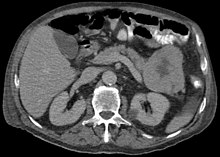Acinar cell carcinoma of the pancreas
| Acinar cell carcinoma of the pancreas | |
|---|---|
| Other names | Acinar cell carcinoma |
 | |
| Micrograph of an acinar cell carcinoma of the pancreas. H&E stain. | |
| Specialty | Oncology |
Acinar cell carcinoma of the pancreas, also acinar cell carcinoma, is a rare
exocrine tumour of the pancreas. It represents 5% of all exocrine tumours of the pancreas, making it the second most common type of pancreatic cancer.[1]
It is abbreviated ACC. It typically has a guarded prognosis.
Signs and symptoms

The disease is more common in men than women and the average age at diagnosis is about 60.[2] Symptoms are often non-specific and include weight loss. A classic presentation, found in around 15% of cases includes
Pathology
ACC is associated with increased serum lipase and manifests in the classic presentation known as the Schmid triad (subcutaneous fat necrosis, polyarthritis, eosinophilia).[3]
ACC are typically large, up to 10 cm, and soft compared to pancreatic adenocarcinoma, lacking its dense stroma. They can arise in any part of the pancreas.[2]
Histomorphologically, the tumour resembles the cells of the
PASD.[4]
Diagnosis


Light microscopy of an acinar cell carcinoma biopsy typically shows granular appearance.[6] Immunohistochemistry is usually positive for trypsin, chymotrypsin and lipase.[6] On genetic testing, altered genes/proteins are typically found for p53, SMAD4, APC, ARID1A and GNAS.[6]
Treatment
ACC can be treated with a
Whipple procedure or (depending on the location within the pancreas) with left partial resection of pancreas.[citation needed
]
See also
References
- ISBN 1118713257, 9781118713259
- ^ ISBN 0763721786, 9780763721787
- PMID 20168061.
- S2CID 19317244.
- PMID 21721197.)
{{cite journal}}: CS1 maint: multiple names: authors list (link
Diagram by Mikael Häggström, M.D. - ^ PMID 28299752.
